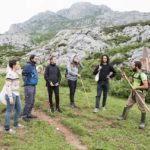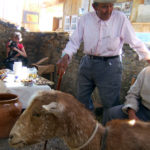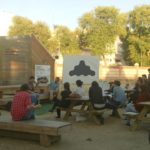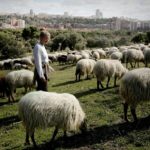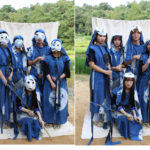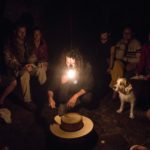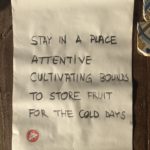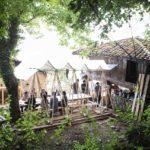*English text follows Japanese one.
土地に根ざした新しいビジョン:スペインのアートコレクティブINLANDの事例から/フェルナンド・ガルシア・ドリー
今日の農村地域:可能性の場所
私たちは今、全人口の過半数が都市に住むという歴史的瞬間にいます。先進国では、平均2%の人口が農業に従事しており、その平均年齢は60歳を超えています。
これは「グレート・アクセラレーション」と呼ばれる、1950〜1960年代から今日まで続く、資本主義と化石燃料の広範囲な使用に関連したプロセスがもたらした結果だと言えるでしょう。
しかしこの急激な成長は、一体どこまで進むのでしょうか? 1972年、マサチューセッツ工科大学の科学者たちはこの問いについて研究を行い、『成長の限界』と題された報告書を出版しました。彼らは初期のコンピュータを駆使し、現在の傾向から未来を予測するモデルを割り出したのです。当時広く読まれたこの報告書では、「この継続的な成長は、有限の世界には収まりきれない無限の量に達する」とする基本的な命題が確認されています。
「無限の成長」という考えは、農業において中心的な考えである循環性や循環型経済の対極にあります。農業においては、(例えば土壌など)富の源が補填される限りにおいて、抽出―より良い言い方をすると、収穫できます。この考えは農民の持続的実践の中核をなしており、その中では蓄財ではなく「生命の再生産が目指されています。
『成長の限界』の出版から50年が経ち、私たちはこの現代文明の基盤そのものを再考する必要があるかもしれないということに気づき始めました。ここで、天然資源の管理や、他者そして時間と関わるための別の形態、満足という考えや「グッドライフ」の見解、あるいはアンデス山脈先住民族であるケチュア族が育んできた概念「スマックカウサイ(Sumak Kawsay)」に目を向けてみます。テクノサイエンス重視の植民地主義経済が拡大するプロセスにおいて、取り残され、忘れられ、打ち負かされてきた、農民や先住民文化によって育まれたもうひとつの生活様式は今、滅亡寸前の人類を「再起動」させるために重要な、知識や経験の宝庫となっています。
農村とは通常、住民の居住密度によって定義されます。しかしどういうわけか、この言葉を定義するのは思った以上に困難です。
農村とは、取り残され、沈黙させられた、しかし永続的な「異質なるもの」であり、あるときは不安や孤立、またあるときは牧歌的理想主義と結びつけて考えられてきました。いずれにせよ、根源的な変革をともなうこの不確実な時代において、先に述べたような記憶、知識、関係性の集積を研究するときには、それを生み出してきた農民や先住民族に対して正当なケアや配慮がなされるべきでしょう。この都市と地方の再結合は、より持続的な未来に向けて、社会が移行するための鍵となる可能性を秘めているのです。
私たちはどのようにして、都市と農村の間になくてはならない架け橋を作れるのでしょうか? どうすれば再び農村を、機会と満足が得られる「グッドライフ」の場所にすることができるのでしょうか?
私たちは、農村についての文化戦略を概念化・開発すること、新しいビジョンを拡張すること、そしてその価値や、未来への可能性を明確にすることが必須だと考えています。そしてアートを通してこのことを遂行するのが、最良の方法だと信じています。
土地に根ざした、新しいアートシステムのプロトタイプ
INLANDは、土地、地政学、文化、アイデンティティについて、スペインの都市と地方の関係におけるそれぞれの役割を調査するプロジェクトとして、2009年にスタートしました。
農村生活を支援する文化戦略を立ち上げることを目的として、最初の3年間(2010〜2013年)に国内の22の村でアーティスト・イン・レジデンス・プログラムを実施し、芸術的な生産活動を立ち上げました。そして国際会議や展覧会を開催したり、書物を出版しました。
アーティスト、農家、知識人、農村開発のエージェント、政策立案者、キュレーター、美術評論家、その他の人々が農村と都市から集められ、彼らの研究や実践を発表するためのオープンなプラットフォームが提供されました。農村地域の未来についての公開討論を開くため、彼らの研究や実践内容が集められ、そして社会に広く発信されました。
スペインには、人口の非常に少ない農村地域(国土の80%を占める)が広がっていて、村が放棄されるに従い、このような土地はさらに増えていくということを考慮すべきです。同時に、特に若年層の高い失業率についても考えなければなりません。
どうしたら農村を、興味深く、新しい生活を始めるに値する場所にできるのでしょうか? 世界的パンデミックの時代にあり、経済の不安定さが増し、都市生活の質が低下する中で、ますます多くの都市生活者が人生の意味を問うようになりました。今、この問いは非常に重要です。
現在INLANDでは、私たちが「有用」と呼ぶアートの形態を実験しています。特定の問いや課題に答えることができるという意味での「有用」であり、その問いと課題はINLANDの実践が行われる特定の農村コミュニティと共に決定されるのです。
私たちは、農村地域におけるアグロエコロジーの拡大に貢献できると考えています。アグロエコロジーとは、社会的に公正で、環境的に持続可能で、経済的に実現可能な農業生態系を作り出すための3つの生産モデルを指しています。私たちはこれら3つの項目に「文化的に活気ある」という4つ目の側面を追加します。
これまでINLANDが開発してきたプロジェクトにはいくつかの共通点があります。それは、モノよりもプロセスを優先した作品であること、地域コミュニティの参加と共同創作を促進する作品であること、批評的思考、コミュニティの活性化、農家のエンパワーメントに貢献する作品であることです。
私は「自分が住みたいと思える地方とアートシステムを作る」ことを目指し、INLANDをスタートさせました。 INLANDは、スペイン北部山間部の廃村、マドリッド市のCentre for the Approach of the Ruralと呼ばれる都市型の羊舎を備えた建物、マヨルカ島の中世の大修道院という3つの場所で、アートとアグロエコロジーのコレクティブとして進化してきました。
私たちは本を出版し、ラジオのポッドキャストを立ち上げ、展覧会を企画し、またチーズを作るために羊や山羊を飼っています。
活動のコンセプトは、アーティストや農家を巻き込んだ、土地に根ざしたコラボレーション、経済、実践共同体のためのスペースを開くことにあります。教育もINLANDの活動の重要な側面です。例えば、地元の農家と協働し、学問的知識やその土地固有の知識を構築するため、牧羊者学校、農民指導者育成学校、そしてヨーロッパの多数の大学から建築、社会学、アート、景観学といった多様な分野の学生を集める「新しいカリキュラム」と呼ばれるプロジェクトなどの教育カリキュラムを実施しています。
私たちのコレクティブはまた、さまざまな国や場所でアートプロジェクトを実施するために招待を受けていますが、村の再建プロジェクトといった、INLANDの場所で起こっていることの共鳴箱となるような提案を心がけています。現在は、自身の生産活動によりさらに自立的になることを目標としており、「チーズコイン」と呼ばれる、プロジェクトの支援者たちのコミュニティ内で流通する独自通貨を立ち上げることを検討しています。
私たちは、さまざまな場所で行われている、同じ考えを持ったプロジェクトとの間に、交換と相互支援のネットワークを構築することが非常に重要だと考えています。これが「Confederacy of Villages」プロジェクトを発展させる理由です。また、5年ごとにドイツで開催されアート界で最も影響力があるとされる「ドクメンタ」の次回展を企画する、国際ネットワーク「ルンブン」に参加する理由でもあります。次回展の中心コンセプトは、インドネシアの農村地域にあるルンブンと呼ばれる共同米倉にまつわるものです。この米倉にすべての村人から米が納められ、そして後に必要とする人々に再分配されるのです。私たちが生きることになる困難や危機の時代において、連帯の一形態であるこの米倉から学べることがあります。
今こそ、アーティストでルーマニア国立農民博物館館長でもあるベルネア・ホリアが、1990年に述べた言葉を思い出すときかもしれません。
「私たちは、ほとんど失われた伝統文化の古さ、美しさ、力や有機性を示したいのではありません。人は現在や未来がある限りにおいて過去に興味を持つのです。私たちは、人々が彼らの先祖と比べてどれほど精神的に貧しいかを示そうとしているだけです。人々が受け継いできた豊かさに、警鐘を鳴らさなければなりません」。
フェルナンド・ガルシア・ドリー/Fernando Garcia DORY
1978 年スペイン、マドリッド生まれ。アーティストであり、社会学者であり、農業と環境(生態学)について探求するアグロエコロジスト。自身の仕事を、アート作品を使って社会に変化をもたらし、人間と生物圏との関係を再考する「リビング・カルチャー」のプロデューサーであると語る。その作品は、土地利用、食料生産、農業、そしてそれらを支える社会組織の形態をめぐる問題を研究しており、文化と自然の弁証法、社会的モデル、そして可能な未来についての理解を探求することによって支えられている。ドローイングからアグロエコロジーの協同組合、拡張された彫刻まで、個人や集団でのプロジェクトを通して、チーズ生産、羊飼い、農業、遊牧など、さまざまな実践やプロセスに目を向け、想像力と科学的知識を結びつけて、生産と生活の形態を問いかけている。『Seeds in net』 (2004)、『A Shepherd’s School』(2004)、『A Dairy Museum』 (2012)に加えて、2009年にスタートした『INLAND』は、農業、社会、文化の生産に取り組むコレクティブであり、コラボレーション機関である。
(参考リンク)
Fernando García-Dory
協力:岡田理絵
New Visions from the Land: The Case of the Inland Arts Collective in Spain
Fernando García-Dory
The Rural Today: A Space of Possibility
We are at a point in history when more than half of humanity live in cities. In developed countries, an average 2% of the population is dedicated to farming, with an average age of over 60 years old.
This is the result of the Great Acceleration, the process associated with capitalism and widespread use of fossil fuels since the 1950s and 1960s until today.
But how far can that exponential growth go? This was studied in the 1972 by scientists at Massachusetts Institute of Technology, who published a report, “The Limits to Growth,” using the first computers to determine models of projection for current trends. This widely noted report confirmed the basic thesis that “the continued growth leads to infinite quantities that just do not fit into a finite world.”
The idea of infinite growth is the opposite of the circularity and cyclical economy that dominates agriculture: one can extract, or better said, harvest, as far as the source of wealth—for example, the soil—is replenished. This was at the core of sustainable peasant practices and within it, the goal is the reproduction of life, not cumulative growth.
Fifty years after “The Limits of Growth” was published, we have started to realize the need to reconsider the very basis of our current civilization. We look to other forms of managing natural resources and of interacting with others, to time, and to ideas of fulfillment and notions of “good living” or Sumak Kawsay, a concept developed by the Kichwa indigenous peoples in the Andean Mountains of South America. Those other ways of living––developed by rural peasant and indigenous cultures that were left aside, forgotten, and defeated in the expansion of techno-scientific colonialist economies of growth––constitute now an important reservoir of knowledge and experience that appears crucial for “rebooting” humanity on the verge of collapse.
The rural is usually defined by the level of density of human settlements on the land. But it is somehow more difficult to define.
The rural is the last silenced but persistent “otherness,” regarded at times with apprehension and detachment, and bucolic idealism at others. In any case, this collection of memories, knowledge, and relationships must be studied with the due care and attention that they deserve in these uncertain times of radical transformation. This reunion between the city and the countryside may hold the key to society’s transition toward a more sustainable future.
How could we create this necessary bridge between the urban and the rural? How to make the rural again a space that becomes a space of opportunity, of satisfaction, of good living?
This involves, in our view, the conceptualization and development of a cultural strategy on the rural, extending a new vision and articulating its values and potentials for the future. And we believe the best way to do that is through the arts.
A Prototype of a New Art System Rooted in the Land
INLAND started in 2009 as a project to examine the role of territories, geopolitics, culture, and identity in the relationship between the city and the countryside in Spain.
Its objective was to launch a cultural strategy in support of rural life, and over an initial period of three years (2010–13), we launched an international conference, exhibitions, publications, and artistic production through an artist residency program throughout 22 villages around the country.
The project intended to gather, among others, artists, farmers, intellectuals, rural development agents, policymakers, curators, and art critics from the rural and urban spheres, on an open platform for presenting their research and practice. The content was gathered before general release to first open a public debate on the future of rural areas.
We have to consider that Spain has vast rural areas (80% of the country) with very little population, and the abandonment of villages will further increase rural areas. At the same time, there is a high level of unemployment, especially among young people.
How to make the rural an interesting and possible place to start a new life? This is a crucial question now as we see more and more people in the city questioning their life purpose, with growing economic precarity and the quality of life in the city diminishing during the global pandemic.
We are now at INLAND experimenting with forms of art that we call “useful,” meaning that they answer specific questions or challenges determined together with a specific rural community where our practice should be located.
We believe in contributing to the extension of agroecology in rural areas. Agroecology is a model of production that aims to create agroecosystems that are socially fair, environmentally sustainable, and economically feasible. We add a fourth dimension: they should also be culturally vibrant.
The projects we developed sometimes share various aspects: artworks that are more processes than objects, that promote participation and co-creation with the local community, that contribute to critical thinking, community activation, and empowering farmers.
I started INLAND aspiring to “create the countryside and art system I would like to live in.” INLAND has evolved into an art and agroecological collective in three different locations: an abandoned village in the northern mountains of Spain, a building in Madrid called the Centre for the Approach of the Rural with an urban sheep, and a medieval abbey on the island of Mallorca.
We publish books, make radio podcasts, and produce art shows. We also have our own sheep and goats to make cheese.
The idea is to open space up for land-based collaborations, economies, and communities of practice involving artists and farmers. Education also constitutes an important aspect of their activities. In addition to Shepherd’s School and School for Peasant Leaders, the New Curriculum is a project bringing together students of many universities in Europe, and different disciplines, such as architecture, sociology, arts, and landscape studies to work with local farmers and compose knowledge that is both academic and vernacular.
The collective is also invited to produce art projects in different countries and places, but try to make proposals that are like resonance boxes of what is happening in our INLAND spaces, such as the village we are rebuilding. A main objective now is to be more self-reliant with our own productions, and therefore we are considering to launch our own currency, the Cheesecoin, a form of currency that will circulate among a community of supporters.
We believe it is very important to create networks of exchange and mutual support among like-minded projects in different locations. This is why we are developing the Confederacy of Villages project as well as taking part in the global network of projects at the next Documenta, an art exhibition that happens in Germany every five years and regarded as the most influential event in the art world. The central concept for the exhibition is lumbung, the Indonesian name for a collective rice barn to which all the villagers contribute and later use to redistribute to those in need. It is a form of solidarity we can learn from in times of difficulty and crisis.
Maybe it is now time to remember the words that Horia Bernea, an artist and former director of the National Museum of the Romanian Peasant, said in 1990:
“We don’t want to demonstrate to you the oldness, the beauty and the power and organicity of a traditional culture which is almost gone. We are interested in the past as far as we have a present and a future. We only try to demonstrate people how spiritually poor they are compared with their ancestors. They have to be alerted of the richness they inherited.”
—
Fernando García-Dory (b.1978 in Madrid, Spain) is an artist, sociologist, and agroecologist. He speaks about his work as a producer of “living culture”, using art production to precipitate social change and reconsider our relationship to the biosphere. His work investigates questions surrounding land use, food production and farming, and the forms of social organization that frame them. It is aided through an enquiry into understandings of the culture-nature dialectic, social modeling, and of possible futures. Through individual and collective projects, from drawings to agroecological cooperatives, expanded sculpture and more, Garcia-Dory looks at cheese production, shepherding, farming, and nomadism, among other practices and processes, in a way that bridges imagination and scientific knowledge to question forms of producing and living. Along with “Seeds in net” (2004), “A Shepherd’s School” (2004), and “A Dairy Museum” (2012), “INLAND” is an arts collective and a collaborative agency started in 2009, dedicated to agricultural, social, and cultural production.

